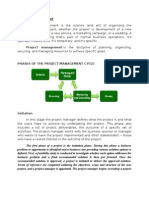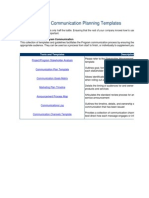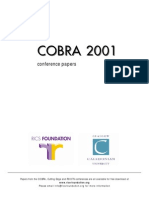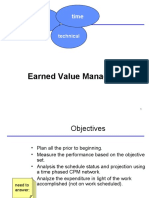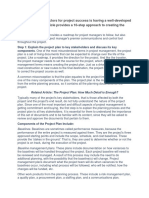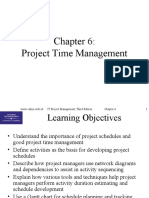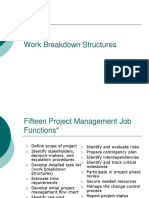100%(1)100% found this document useful (1 vote)
331 viewsWork Breakdown Structure
Work Breakdown Structure
Uploaded by
mo0onshah1. The document discusses various project time management processes and techniques for planning and scheduling projects, including developing a work breakdown structure (WBS), estimating activity durations, critical path method (CPM), program evaluation and review technique (PERT), and Gantt charts.
2. It emphasizes the importance of developing a detailed WBS to break down the project into work packages for estimating, scheduling, and tracking purposes. Estimating techniques include bottom-up and top-down approaches.
3. CPM and PERT are introduced as network-based scheduling methods to identify the critical path and analyze schedule risks. Gantt charts are commonly used to display project schedules and track progress over time.
Copyright:
© All Rights Reserved
Available Formats
Download as PPT, PDF, TXT or read online from Scribd
Work Breakdown Structure
Work Breakdown Structure
Uploaded by
mo0onshah100%(1)100% found this document useful (1 vote)
331 views44 pages1. The document discusses various project time management processes and techniques for planning and scheduling projects, including developing a work breakdown structure (WBS), estimating activity durations, critical path method (CPM), program evaluation and review technique (PERT), and Gantt charts.
2. It emphasizes the importance of developing a detailed WBS to break down the project into work packages for estimating, scheduling, and tracking purposes. Estimating techniques include bottom-up and top-down approaches.
3. CPM and PERT are introduced as network-based scheduling methods to identify the critical path and analyze schedule risks. Gantt charts are commonly used to display project schedules and track progress over time.
Copyright
© © All Rights Reserved
Available Formats
PPT, PDF, TXT or read online from Scribd
Share this document
Did you find this document useful?
Is this content inappropriate?
1. The document discusses various project time management processes and techniques for planning and scheduling projects, including developing a work breakdown structure (WBS), estimating activity durations, critical path method (CPM), program evaluation and review technique (PERT), and Gantt charts.
2. It emphasizes the importance of developing a detailed WBS to break down the project into work packages for estimating, scheduling, and tracking purposes. Estimating techniques include bottom-up and top-down approaches.
3. CPM and PERT are introduced as network-based scheduling methods to identify the critical path and analyze schedule risks. Gantt charts are commonly used to display project schedules and track progress over time.
Copyright:
© All Rights Reserved
Available Formats
Download as PPT, PDF, TXT or read online from Scribd
Download as ppt, pdf, or txt
100%(1)100% found this document useful (1 vote)
331 views44 pagesWork Breakdown Structure
Work Breakdown Structure
Uploaded by
mo0onshah1. The document discusses various project time management processes and techniques for planning and scheduling projects, including developing a work breakdown structure (WBS), estimating activity durations, critical path method (CPM), program evaluation and review technique (PERT), and Gantt charts.
2. It emphasizes the importance of developing a detailed WBS to break down the project into work packages for estimating, scheduling, and tracking purposes. Estimating techniques include bottom-up and top-down approaches.
3. CPM and PERT are introduced as network-based scheduling methods to identify the critical path and analyze schedule risks. Gantt charts are commonly used to display project schedules and track progress over time.
Copyright:
© All Rights Reserved
Available Formats
Download as PPT, PDF, TXT or read online from Scribd
Download as ppt, pdf, or txt
You are on page 1of 44
1Kehk
COMP442 Project Management
2
Session Objectives
Planning & scheduling
Work Breakdown Structure
Realistic Estimating
Critical Path
3
4
Project Time Management Processes
Project time management involves
processes required to ensure timely
completion of a project
Processes include:
Activity definition
Activity sequencing
Activity duration estimating
Schedule development
Schedule control
Estimating: Work Breakdown Structure
Project best understood by breaking it down
into its parts
Work Breakdown Structure (WBS)
powerful tool for doing this (not just a task list)
defines the total scope of the project
fundamental to much of project planning & tracking
Start at top, progressively break work down
(tree structure) into work packages
Roll up the packages for bottom up estimating
Packages give clear work assignments
Sample Intranet WBS
Organized by Phase
Intranet WBS in Tabular Form
1.0 Concept
1.1 Evaluate current systems
1.2 Define Requirements
1.2.1 Define user requirements
1.2.2 Define content requirements
1.2.3 Define system requirements
1.2.4 Define server owner requirements
1.3 Define specific functionality
1.4 Define risks and risk management approach
1.5 Develop project plan
1.6 Brief web development team
2.0 Web Site Design
3.0 Web Site Development
4.0 Roll Out
5.0 Support
Intranet WBS and Gantt Chart
Project 98 file
Intranet WBS & Gantt Chart Organized by PM Groups
10
Realistic Estimating (Frame)
Lots of reasons for poor estimates
inexperience, technical problems, changes
optimists, low-balling, politics
Bottom-up cost estimating
rollup the WBS packages
Top-down or Parametric estimating
from experience to complex models
11
Realistic Estimating (cont.)
Which technique is better?
ideally use both
early on dont have WBS so must use
top-down
accuracy of top-down depends on
availability/quality of historical data
building complete WBS can be
expensive, but guesses can be even
more costly
12
Work Package (Marchewka)
13
Deliverables and Milestones
Deliverables
Tangible, verifiable work products
Reports, presentations, prototypes, etc.
Milestones
Significant events or achievements
Acceptance of deliverables or phase
completion
Cruxes (proof of concepts)
Quality control
Keeps team focused
14
Developing the WBS
Develop work packages for each of the
phases and deliverables defined in the
Deliverable Structure Chart (DSC)
15
Work Breakdown Schedule
16
Software Engineering Metrics
Lines of Code (LOC)
Function Points
17
Lines of Code (LOC)
Most traditionally used metric for
project sizing
Most controversial
Count comments?
Declaring variables?
Efficient code vs. code bloat
Language differences
Easier to count afterwards than to estimate
The Application Boundary for
Function Point Analysis
19
The Mythical Man-Month Frederick Brooks
1. 0ur techniques of estimation are
poorly developed.More seriously,
they reflect an unvoiced assumption
which is quite untrue i.e., that all will
go well.
2. Our estimating techniques
fallaciously confuse effort with
progress, hiding the assumption that
men and months are
interchangeable.
20
The Mythical Man-Month Frederick Brooks
3. Because we are uncertain of our
estimates,software managers often
lack the courteous stubbornness of
Antoines chef
4. Schedule progress is poorly
monitored.Techniques proven and
routine in other engineering
disciplines are considered radical
innovations in software engineering
21
The Mythical Man-Month Frederick Brooks
5. When schedule slippage is recognized,
the natural tendency (and traditional)
response it to add more manpower. Like
dousing a fire with gasoline,this makes
matters worse, much worse. More fire
requires more gasoline, and thus begins
a regenerative cycle which ends in
disaster.
22Kehk
Brooks Law:
Adding manpower to a late
software project makes it
later.
23
Scheduling Tools & Methods
Gantt Charts
Critical Path Method (CPM)
Program Evaluation and Review
Technique (PERT)
24
The Project Planning Framework
25
Developing a Project Schedule
Base documents
Project charter
start/end dates (tentative), budget
Scope statement
what will be done (& not done)
Activity definitions
develop detailed WBS
plus supporting explanations to understand
all work to be done
26
Activity Sequencing
Review activities & determine
dependencies
Mandatory dependencies: inherent in the
nature of the work; hard logic
Discretionary: defined by the project team;
soft logic
External: involve relationships between
project and external activities
Must determine dependencies to use
critical path analysis
27
Gantt Charts
Created 1800
Standard format for displaying
project schedules
activities, durations, start/end finish
dates displayed in calendar format
Advantages
enforces planning
easy to create & understand
preferred for summary/exec-level
information
28
Gantt Charts (cont.)
Symbols include:
black diamond: milestones
Thick black bars: summary tasks
Lighter horizontal bars: tasks
Arrows: dependencies between tasks
Bar Charts
Simplified version
Serve similar function
29
Sample Project Gantt Chart
Sample Tracking Gantt Chart
white diamond: slipped milestone
two bars: planned and actual times
31
Critical Path Method (CPM)
Developed 1957
CPM diagram shows activities,
durations, start/end dates & sequence
in which they must be completed
Critical path for project is the series of
activities that determines the earliest
time by which project can be
completed
Critical path is longest path through
network diagram, has least (zero) slack
or float
32
CPM (cont.)
Critical path helps you make
schedule trade-offs
Slack or float amount of time
activity can be delayed without
delaying early start of dependent
activities
Simple Example of Determining Critical Path
consider following network diagram
assume all times in days
2 3
4
5
A=2 B=5
C=2
D=7
1
6
F=2
E=1
start finish
a. How many paths are on this network diagram?
b. How long is each path?
c. Which is the critical path?
d. What is the shortest amount of time needed to
complete this project?
Activity-on-Arrow (AOA) Network Diagram
34
Precedence Diagramming Method (PDM)
Activities are represented by boxes
Arrows show relationships between
activities
More popular than ADM method as
used by PM software
Better at showing different types of
dependencies
Task Dependency Types
36
Activity Analysis for AON
Activity Description Estimated
Duration
(Days)
Predecessor
A
Evaluate current technology
platform
2 None
B
Define user requirements
5 A
C
Design Web page layouts
4 B
D
Set-up Server
3 B
E
Estimate Web traffic
1 B
F
Test Web pages and links
4 C,D
G
Move web pages to production
environment
3 D,E
H
Write announcement of
intranet for corp. newsletter
2 F,G
I
Train users
5 G
J
Write report to management
1 H,I
37
Possible Activity Paths
Possible Paths Path Total
Path 1 A+B+C+F+H+J 18
2+5+4+4+2+1
Path 2 A+B+D+F+H+J 17
2+5+3+4+2+1
Path 3 A+B+D+G+H+J 16
2+5+3+3+2+1
Path 4 A+B+D+G+I+J 19*
2+5+3+3+5+1
Path 5 A+B+E+G+I+J 17
2+5+1+3+5+1
38
Critical Path
Longest path
Shortest time project can be completed
Zero slack (or float)
The amount of time an activity can be delayed
before it delays the project
Must be monitored and managed!
PM can expedite or crash
Can fast track
The CP can change
Can have multiple CPs
39
Techniques for Shortening a Project Schedule
Shortening durations of critical tasks:
add more resources
change their scope
Crashing tasks by obtaining the greatest
amount of schedule compression for the
least incremental cost
Fast tracking tasks by doing them in
parallel or overlapping them
40
PERT
Developed 1959 for Polaris project
Similar to CPM but addresses
uncertainties in task durations
Uses probabilistic time estimates
optimistic, most likely, pessimistic
estimates of activity durations
PERT Formula and Example
PERT weighted average formula:
optimistic time + 4X most likely time + pessimistic time
6
Example:
PERT weighted average =
8 workdays + 4 X 10 workdays + 24 workdays = 12 days
6
where 8 = optimistic time, 10 = most likely time, and 24 =
pessimistic time
Activity Analysis for PERT
Activity Predecessor Optimistic
Estimates
(Days)
Most Likely
Estimates
(Days)
Pessimistic
Estimates
(Days)
Expected
Duration
(a+4b+c)
6
A None 1 2 4 2.2
B A 3 5 8 5.2
C B 2 4 5 3.8
D B 2 3 6 3.3
E B 1 1 1 1.0
F C,D 2 4 6 4.0
G D,E 2 3 4 3.0
H F,G 1 2 5 2.3
I G 4 5 9 5.5
J H,I .5 1 3 1.3
30 days 31.6 days
43
Selecting Scheduling Approach
Consider project size, risk and
complexity
Gantt
senior management
smaller, less complex projects
CPM
medium size/complexity/risk
PERT
high risk projects
medium to high complexity
44
You might also like
- Alison Learner RecordDocument8 pagesAlison Learner Recordmanuieee100% (1)
- Aluminum Alloy Castings Properties Processes and Applications PDFDocument321 pagesAluminum Alloy Castings Properties Processes and Applications PDFEmílio BeckerNo ratings yet
- Project Management Tools and TechniquesDocument32 pagesProject Management Tools and TechniquesTariq Bezinjo100% (1)
- Project ManagementDocument4 pagesProject ManagementglennNo ratings yet
- Estimating MethodsDocument10 pagesEstimating MethodsAer AsedoNo ratings yet
- Gantt Chart HistoryDocument9 pagesGantt Chart HistoryJonathan AmpisNo ratings yet
- Construction Cost - CalculatorDocument14 pagesConstruction Cost - CalculatorRahul SinghNo ratings yet
- What Is A Problem Statement: Definition and ExampleDocument16 pagesWhat Is A Problem Statement: Definition and Exampleally jumanne100% (1)
- Project ManagementDocument48 pagesProject ManagementoedhieNo ratings yet
- Preliminary Project Scope StatementDocument5 pagesPreliminary Project Scope StatementShah Rukh RayazNo ratings yet
- Analysis of Rates 07 Vol - 2Document650 pagesAnalysis of Rates 07 Vol - 2supriyo.podderNo ratings yet
- Template - Financial PlanDocument10 pagesTemplate - Financial PlanGryswolf100% (1)
- Educational RESEARCH (837) : Ismail TariqDocument15 pagesEducational RESEARCH (837) : Ismail TariqRida Waheed100% (1)
- PM Chapter-5Document18 pagesPM Chapter-5GolamSarwar100% (1)
- A1 - Critical Review of The Causes of Cost Overrun in Construction Industries in Developing CountriesDocument10 pagesA1 - Critical Review of The Causes of Cost Overrun in Construction Industries in Developing CountriesTong Yi NieNo ratings yet
- Case+Analysis+1 2Document3 pagesCase+Analysis+1 2ViŠhål Pätěl50% (2)
- SPM Chapter 1Document38 pagesSPM Chapter 1Ndoba HakimNo ratings yet
- What Is PJ. Management?: Handover & CelebrateDocument55 pagesWhat Is PJ. Management?: Handover & CelebratetommybungtoNo ratings yet
- Effect of Organizational Culture On Delay in Construction PDFDocument12 pagesEffect of Organizational Culture On Delay in Construction PDFashikNo ratings yet
- 5 Cost EstimatingDocument30 pages5 Cost EstimatingdandyauroraNo ratings yet
- Project Communication Planning Templates: Process To Facilitate Program CommunicationDocument25 pagesProject Communication Planning Templates: Process To Facilitate Program Communicationpamoli01No ratings yet
- All-In Labour Rate Build-Up - EstimatingDocument3 pagesAll-In Labour Rate Build-Up - EstimatingMichael WaltersNo ratings yet
- Value and RiskmanagementDocument11 pagesValue and RiskmanagementShonette ThomasNo ratings yet
- DOP1000-PRC-001!0!02 Client Review RequirementsDocument6 pagesDOP1000-PRC-001!0!02 Client Review RequirementsgfgfNo ratings yet
- Simple Gantt Chart MsDocument3 pagesSimple Gantt Chart MsAbi AyeshaNo ratings yet
- Earned Value Management: Cost TechnicalDocument37 pagesEarned Value Management: Cost TechnicalkrishnaNo ratings yet
- Project PlanningDocument39 pagesProject PlanningDoc Rishibha BhardwajNo ratings yet
- Ax2012 Si WBSDocument36 pagesAx2012 Si WBSAli FakihNo ratings yet
- Project Management HandbookDocument6 pagesProject Management HandbookReza Noor MuinNo ratings yet
- Project Management For Construction - Cost Control, Monitoring and AccountingDocument29 pagesProject Management For Construction - Cost Control, Monitoring and Accountingapi-27145250100% (1)
- Strategic PlanningDocument5 pagesStrategic PlanningArun TanwarNo ratings yet
- Stakeholder Priority MatrixDocument4 pagesStakeholder Priority MatrixnabilredascribdNo ratings yet
- Project Integration Management: Shwetang Panchal Sigma Institute of Management StudiesDocument32 pagesProject Integration Management: Shwetang Panchal Sigma Institute of Management StudiesShwetang PanchalNo ratings yet
- Pembuatan Proposal ProyekDocument41 pagesPembuatan Proposal ProyekpudjijatiNo ratings yet
- PMC TorDocument85 pagesPMC ToragungNo ratings yet
- JBCC Priceindex September 2022Document7 pagesJBCC Priceindex September 2022kandy saidNo ratings yet
- CM1Document61 pagesCM1somapala88No ratings yet
- CHAPTER 6 Managing Event As A ProjectDocument28 pagesCHAPTER 6 Managing Event As A ProjectEni Syafina RoslanNo ratings yet
- Escalation-Matrix 1685342662Document5 pagesEscalation-Matrix 1685342662NikiNo ratings yet
- Business Administration Notes 27th April 11Document57 pagesBusiness Administration Notes 27th April 11Danny WongNo ratings yet
- Project Completion PPM Version 2.0Document13 pagesProject Completion PPM Version 2.0keys.linkNo ratings yet
- 1920 Lect 01 IntroductionDocument45 pages1920 Lect 01 IntroductionQayyumNo ratings yet
- Lecture - 11 - Rate Analysis - Estimation and Costing - AmiteshDocument15 pagesLecture - 11 - Rate Analysis - Estimation and Costing - AmiteshSupriya DasNo ratings yet
- Smu 4rt Sem Project Management AssignmentsDocument14 pagesSmu 4rt Sem Project Management AssignmentsProjectHelpForuNo ratings yet
- Construction CostDocument2 pagesConstruction CostKira YamatoNo ratings yet
- Project Time Management: 1 WWW - Cahyo.web - Id IT Project Management, Third Edition Chapter 6Document46 pagesProject Time Management: 1 WWW - Cahyo.web - Id IT Project Management, Third Edition Chapter 6cahyod100% (1)
- Engineering ManagementDocument27 pagesEngineering ManagementKevin SanchezNo ratings yet
- PROJECT OVERHEAD COSTDocument6 pagesPROJECT OVERHEAD COSTshiela mesiasNo ratings yet
- Baseline Compliance Analysis: Dr. Dan Patterson, PMPDocument10 pagesBaseline Compliance Analysis: Dr. Dan Patterson, PMPCad NoviceNo ratings yet
- Lecture 6 - Network Scheduling TechniquesDocument35 pagesLecture 6 - Network Scheduling TechniquesNen Tran Ngoc60% (5)
- Chap 04Document25 pagesChap 04iloveeru02No ratings yet
- PMI Knowledge Areas: Project Time ManagementDocument42 pagesPMI Knowledge Areas: Project Time ManagementEllaNo ratings yet
- Work Breakdown StructuresDocument45 pagesWork Breakdown Structuresaswathi1No ratings yet
- Systems Analysis and Design: 03 Managing The Information Systems ProjectDocument40 pagesSystems Analysis and Design: 03 Managing The Information Systems ProjectJ A Y T R O NNo ratings yet
- Information Technology Project Management (UCCD2043)Document38 pagesInformation Technology Project Management (UCCD2043)vickramravi16No ratings yet
- Presentation JanDocument84 pagesPresentation JanYatin MalhotraNo ratings yet
- Managing Systems Project (Chapter-3)Document40 pagesManaging Systems Project (Chapter-3)Ayisha ManzoorNo ratings yet
- Chapter - 11A - OPIM 230 - PROJECT MANAGEMENT (2) (Autosaved)Document60 pagesChapter - 11A - OPIM 230 - PROJECT MANAGEMENT (2) (Autosaved)alyaaNo ratings yet
- Project Time ManagementDocument56 pagesProject Time ManagementusmansafdarNo ratings yet
- Chapter 3 Project Management (Lec 7)Document22 pagesChapter 3 Project Management (Lec 7)Esraa AlaaNo ratings yet
- Work Breakdown Structures de PMI PDFDocument45 pagesWork Breakdown Structures de PMI PDFGladys Sánchez100% (1)
- Topic: Means & Modes of Corporate Financing: Roll No: AR523573 Presented By: Syed Muneeb Haroon Presented To: Sir WaqasDocument14 pagesTopic: Means & Modes of Corporate Financing: Roll No: AR523573 Presented By: Syed Muneeb Haroon Presented To: Sir Waqasmo0onshahNo ratings yet
- Sept Vegetarian Lunch Menu 2013Document1 pageSept Vegetarian Lunch Menu 2013mo0onshahNo ratings yet
- Joint Stock CompanyDocument35 pagesJoint Stock Companymo0onshahNo ratings yet
- HR Practices in National Bank of PakistanDocument35 pagesHR Practices in National Bank of Pakistanmo0onshah0% (1)
- Aip EbciDocument50 pagesAip Ebcigiuseppe751No ratings yet
- Mix Design Report For M-30 Grade of Concrete: M/s Aegis Logistics LTDDocument5 pagesMix Design Report For M-30 Grade of Concrete: M/s Aegis Logistics LTD123shripadNo ratings yet
- 7.circulating Fluidized BedsDocument60 pages7.circulating Fluidized BedsPITICINFURIATNo ratings yet
- Column Properties:-: Due To UplitDocument2 pagesColumn Properties:-: Due To UplitRohit SinghNo ratings yet
- Contoh Program Matlab Gauss SeidelDocument11 pagesContoh Program Matlab Gauss SeidelTeguh Weda AnggaNo ratings yet
- V33 Service ManualDocument76 pagesV33 Service ManualMary Flynn NettlesNo ratings yet
- Paper GeofisikaDocument11 pagesPaper GeofisikaMuhammad Tri RizkiNo ratings yet
- ASEANNCAPVehicle Selection CriteriaDocument9 pagesASEANNCAPVehicle Selection CriteriaJesse SimonNo ratings yet
- Introduction of PPICDocument16 pagesIntroduction of PPICsuciNo ratings yet
- Gates DriveAlignTensioners Brochure enDocument4 pagesGates DriveAlignTensioners Brochure ensupljinaNo ratings yet
- Otis One Plus Video Gateway Box 10-Aaa21305ggDocument5 pagesOtis One Plus Video Gateway Box 10-Aaa21305ggasdfNo ratings yet
- Checklist AsetDocument8 pagesChecklist AsetcheanhoiNo ratings yet
- ThereminDocument18 pagesThereminzeljkokerumNo ratings yet
- Rotodynamic Machines: Engine or Motor Is UsedDocument25 pagesRotodynamic Machines: Engine or Motor Is UsedWika ElmasryNo ratings yet
- LeachingDocument11 pagesLeachingFakhirah Ahmad BasriNo ratings yet
- RCC Slab BridgeDocument12 pagesRCC Slab BridgeSanjay GargNo ratings yet
- 9ha Fact Sheet Oct15Document2 pages9ha Fact Sheet Oct15Zulfiqar AliNo ratings yet
- FA D155AX-6 80001-Up GEN00049-03Document118 pagesFA D155AX-6 80001-Up GEN00049-03RimbertNo ratings yet
- Week 04, Memory ManagementDocument31 pagesWeek 04, Memory Managementnino sulitNo ratings yet
- L9Series GPS AntennaDocument1 pageL9Series GPS AntennaDAVID ROBINSONNo ratings yet
- Chapter 2, Oct 8Document24 pagesChapter 2, Oct 8Sabin Leroy HmgnNo ratings yet
- Analytical ChemistryDocument7 pagesAnalytical ChemistryLouisa WongNo ratings yet
- Similar BoardsDocument11 pagesSimilar BoardsAbhinavRajmalwarNo ratings yet
- Durability and Strength Evaluation of High-Performance Concrete in Marine StructuresDocument7 pagesDurability and Strength Evaluation of High-Performance Concrete in Marine StructuresCarlos GarridoNo ratings yet
- Layout Complexity Does It Measure UsabilityDocument7 pagesLayout Complexity Does It Measure UsabilitymarbosnNo ratings yet
- IIT KGP Time TableDocument45 pagesIIT KGP Time TablePujanNo ratings yet
- 1 s2.0 S135943112100733X AmDocument29 pages1 s2.0 S135943112100733X AmerbgawdweNo ratings yet
- Suppliers - Brompton, 2008.07 Order FormDocument1 pageSuppliers - Brompton, 2008.07 Order FormvelorutionNo ratings yet



